
Ewenny Priory, in Ewenny in the Vale of Glamorgan, Wales, was a monastery of the Benedictine order, founded in the 12th century. The priory was unusual in having extensive military-style defences and in its state of preservation; the architectural historian John Newman described it as “the most complete and impressive Norman ecclesiastical building in Glamorgan”. Following the Dissolution of the Monasteries, parts of the priory were converted into a private house by Sir Edward Carne, a lawyer and diplomat. This Elizabethan house was demolished between 1803 and 1805 and replaced by a Georgian mansion, Ewenny Priory House. The house is still owned by the Turbervill family, descendants of Sir Edward. The priory is not open to the public apart from the Church of St Michael, the western part of the priory building, which continues to serve as the parish church for the village. The priory is in the care of Cadw and is a Grade I listed building.
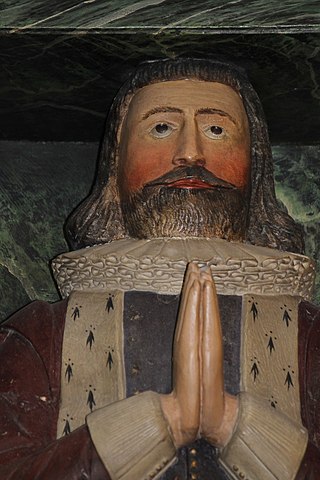
Sir John Trevor I (1563–1630) was a Welsh politician.

Llanfair Dyffryn Clwyd is a village and community in Denbighshire, Wales, situated in the Vale of Clwyd about one mile south of the town of Ruthin. In the 2001 census, it had 1048 residents and 50.6% of them could speak Welsh. The figures for the 2011 census were: population 1,053; Welsh speakers 46.9%. The age group with the highest percentage of Welsh speakers was the 15-year-olds, all of whom could speak it. The villages of Pentrecelyn and Graig Fechan are located in the community.
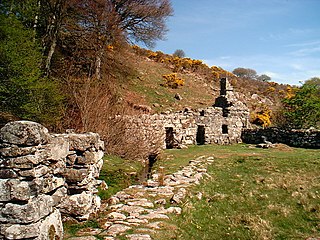
Llangybi(English: Cybi's Church) is a village and former civil parish in the Eifionydd area of the Welsh county of Gwynedd, near Llanarmon. The parish was abolished in 1934 and divided between Llanystumdwy and Llannor.

St Mary's Church, Cilcain, is in the village of Cilcain, Flintshire, Wales. It is an active Anglican church in the Bro Famau group of parishes, in the Mold Mission Area, in the archdeaconry of Wrexham and the diocese of St Asaph. The church is designated by Cadw as a Grade I listed building.

St Michael's Church, Trelawnyd, is in the village of Trelawnyd, Flintshire, Wales. Former Anglican parish church. Previously in the benefice of Dyserth and Trelawnyd and Cwm, the deanery of St Asaph, the archdeaconry of St Asaph, and the diocese of St Asaph. The church is designated by Cadw as a Grade II* listed building.

In the United Kingdom, the term listed building refers to a building or other structure officially designated as being of special architectural, historical, or cultural significance; Grade I structures are those considered to be "buildings of exceptional interest". Listing was begun by a provision in the Town and Country Planning Act 1947. Once listed, strict limitations are imposed on the modifications allowed to a building's structure or fittings. In Wales, the authority for listing under the Planning Act 1990 rests with Cadw.

In the United Kingdom, the term listed building refers to a building or other structure officially designated as being of special architectural, historical, or cultural significance; Grade II* structures are those considered to be "particularly important buildings of more than special interest". Listing was begun by a provision in the Town and Country Planning Act 1947. Once listed, strict limitations are imposed on the modifications allowed to a building's structure or fittings. In Wales, the authority for listing under the Planning Act 1990 rests with Cadw.

The Church of Saint Thomas à Becket in Wolvesnewton, Monmouthshire, Wales has its origins in the 13th century. Restored in the 19th century, it remains an active parish church. St Thomas's is a Grade II* listed building. The medieval churchyard cross was restored as a First World War memorial in 1920 and has its own Grade II* listing.

Llanerch Hall, Trefnant, Clwyd, Wales, is a country house with medieval origins. It was rebuilt twice at the beginning and at the end of the 17th century, was again rebuilt in the 19th century, and further modified in the 20th. The hall is now divided into flats, each with its own Grade II* listing. The parkland, now a golf course, conceals traces of a late 17th century Italianate terraced garden that rivalled those at Powis Castle. The gardens were entirely destroyed in the 19th century rebuilding. The house remains privately owned.
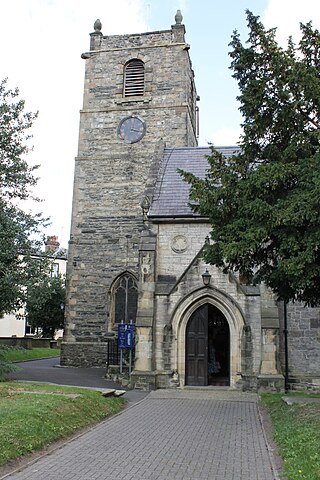
St Collen's Church is a parish church in the town of Llangollen, Denbighshire, Wales. The first church on the site was founded by Collen in the 6th century. Nothing of this building remains. A new church was built in the 13th century, in the Early English Gothic style. This was developed in the succeeding centuries, and then almost completely rebuilt in the 19th century. The architect of the Victorian reconstruction was Samuel Pountney Smith, who retained little of the earlier church, with the exception of the tower. The churchyard contains the grave of the Ladies of Llangollen, Eleanor Charlotte Butler and Sarah Ponsonby, and their servant Mary Carryl, who lived at the nearby Plas Newydd. In November 2021 the first blessing of a gay partnership in a Church in Wales church was held at St Collen's. The church is an active parish church in the Diocese of St Asaph. It is designated by Cadw as a Grade I listed building.

In the United Kingdom, the term listed building refers to a building or other structure officially designated as being of special architectural, historical, or cultural significance; Grade II structures are those considered to be "buildings of special interest which justify every effort being made to preserve them". Listing was begun by a provision in the Town and Country Planning Act 1947. Once listed, strict limitations are imposed on the modifications allowed to a building's structure or fittings. In Wales, the authority for listing under the Planning Act 1990 rests with Cadw.
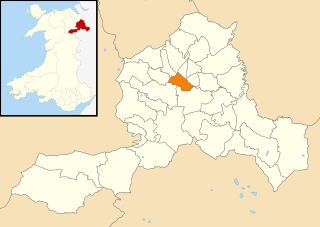
In the United Kingdom, the term listed building refers to a building or other structure officially designated as being of special architectural, historical, or cultural significance; Grade II structures are those considered to be "buildings of special interest which justify every effort being made to preserve them". Listing was begun by a provision in the Town and Country Planning Act 1947. Once listed, strict limitations are imposed on the modifications allowed to a building's structure or fittings. In Wales, the authority for listing under the Planning Act 1990 rests with Cadw.

In the United Kingdom, the term listed building refers to a building or other structure officially designated as being of special architectural, historical, or cultural significance; Grade II structures are those considered to be "buildings of special interest which justify every effort being made to preserve them". Listing was begun by a provision in the Town and Country Planning Act 1947. Once listed, strict limitations are imposed on the modifications allowed to a building's structure or fittings. In Wales, the authority for listing under the Planning Act 1990 rests with Cadw.

Henblas is an Renaissance house in the village of Llanasa, Flintshire, Wales. The mansion dates from 1645 and was built by the Morgan family of Golden Grove, a country estate to the west of Llanasa, as a home for two unmarried sisters. The house is designated by Cadw as a Grade I listed building.

St Bilo's Church, is an active parish church in the village of Llanfilo, Felin-fach, Powys, Wales. The dedication is to Bilo, one of the 24 children of Brychan, a legendary 5th-century king of Brycheiniog. Dating from the 12th century, with later additions, the church was restored by W. D. Caröe in the early 20th century. St Bilo's is designated by Cadw as a Grade I listed building.

St Cynog's Church is an active parish church in the village of Defynnog, Powys, Wales. The dedication is to Saint Cynog, one of the 24 children of Brychan, a legendary 5th-century king of Brycheiniog. Dating from the 15th century, with earlier elements, the church was restored in the late 19th century. The churchyard is notable for its collection of ancient yew trees, the Defynnog Yew which is among the oldest in Britain. St Cynog's is designated by Cadw as a Grade I listed building.

St Aelhaiarn's Church is an active parish church in the village of Guilsfield, Powys, Wales. The village lies 3 miles to the north of Welshpool. The present church dates mainly from the 14/15th centuries, although parts may date back to the 12th. It was restored by George Edmund Street in 1877–1879. The church is designated by Cadw as a Grade I listed building. Its churchyard, which contains a group of ancient yew trees, is designated at Grade II* on the Cadw/ICOMOS Register of Parks and Gardens of Special Historic Interest in Wales.

The Church of St Nefydd and St Mary is an active parish church in the village of Llannefydd, Conwy County Borough, Wales. The village lies 5m south-east of Abergele. Cadw records that the present church dates from c.1550, although it certainly had earlier origins. It was restored in 1859 and again in 1908–1909 by Henry Harold Hughes. The church is designated by Cadw as a Grade I listed building.
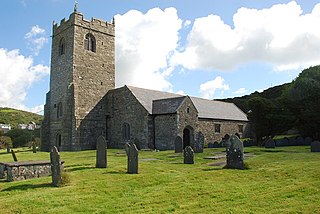
St Engan's Church is an active parish church in Llanengan, Gwynedd, Wales. The village lies in the south of the Llŷn Peninsula, south-west of Abersoch. Cadw records that the current church dates mainly from the 1530s, with 13th century origins. It is a Grade I listed building.




















